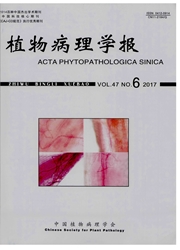

 中文摘要:
中文摘要:
本实验采用DAPI荧光显微镜、PCR、克隆和测序等技术,对海南臭矢菜丛枝病样进行了检测和鉴定。以染病臭矢菜总DNA为模板应用3对植原体特异性引物进行PCR扩增,获得PCR产物为16SrDNA(1430bp)、16S-23SrDNA(358bp)、rpDNA(1294bp)。应用DNA回收试剂盒获得了3个PCR扩增片断的纯化产物,并克隆到DH5a大肠杆菌中测序。应用DNAMAN和MEGA软件对获得的序列与NCBI数据库中植原体序列进行同源性分析和构建系统发育树。结果显示臭矢菜丛枝病植原体与花生丛枝病植原体序列同源性最高,16SrDNA的序列同源性为99.9%,16S-23SrDNA高达100%,伊为99.7%,因而将臭矢菜丛枝病植原体归为花生丛枝组(16SrⅡ),根据16SrDNA的RFLP分析,将其归为16SrⅡ-A亚组。
 英文摘要:
英文摘要:
Cleome witches'-broom phytoplasma (CWB) collected from Hainan Province, was detected and identified using DAPI fluorescence microscopy, PCR, clone and sequencing techniques. Three different type u- niversal primer pairs of phytoplasma were used to amplify 1.43 kb fragment of 16S rDNA, 0.36 kb fragment of 16S-23S rDNA and 1.3 kb fragment of rp DNA. Then PCR-amplified products were cloned and sequenced. The results of sequencing and homologuous comparison with other phytoplasmas showed that cleome witches'-broom phytoplasma shared 99.9 % similarity with peanut witches' -broom phytoplasma in 16S rRNA gene, 100% in 16S-23S rRNA gene and 99.7% in rp gene. Cleome witches '-broom phytoplasma might be sorted into peanut witches'-broom group( 16SrⅡ ), 16Sr Ⅱ - A according to the results of RFLP and sequencing of 16S rDNA.
 同期刊论文项目
同期刊论文项目
 同项目期刊论文
同项目期刊论文
 期刊信息
期刊信息
